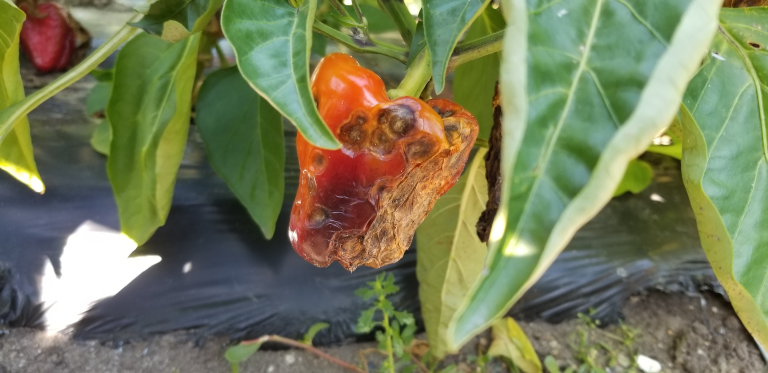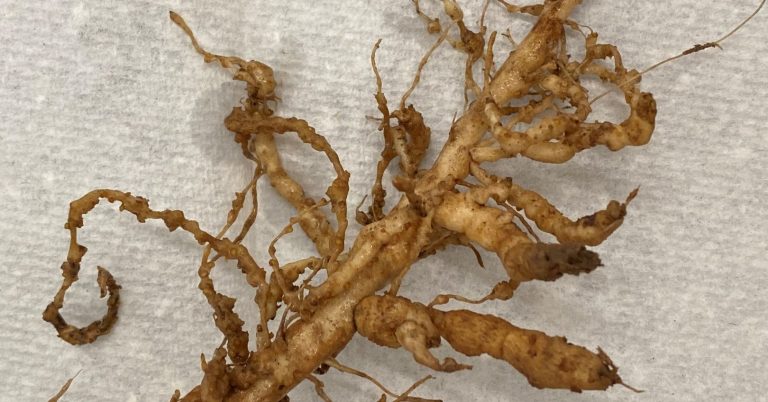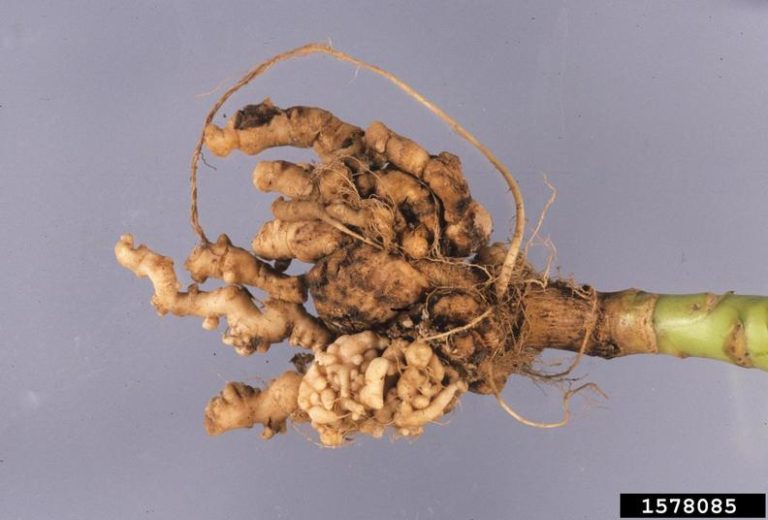Rust diseases of wheat are some of the most devastating and widespread fungal pathogens affecting global wheat production. These diseases, caused by different species of the genus Puccinia, are primarily classified into three major types: Black Rust (Puccinia graminis f. sp. tritici), Yellow Rust (Puccinia striiformis f. sp. tritici), and Brown Rust (Puccinia triticina, formerly P. recondita). Each rust type presents unique challenges to wheat crops and has different environmental preferences, symptomology, and control measures.
In this extensive blog post, we’ll explore these three rust types in great detail, providing in-depth scientific explanations of their life cycles, symptomology, epidemiology, and management strategies. Additionally, we’ll compare the key differences between Black, Yellow, and Brown rust in a tabular format for clarity and quick reference.
1. Introduction to Wheat Rusts
Wheat rusts are caused by obligate parasitic fungi in the genus Puccinia. These fungi are capable of causing severe yield losses and significantly reducing grain quality. The rust fungi have complex life cycles involving multiple spore stages and, in many cases, require two hosts to complete their life cycle, making them heteroecious pathogens.
Rust diseases are favored by specific climatic conditions, which vary between the rust types:
- Black Rust thrives in warm, moist conditions.
- Yellow Rust prefers cooler, humid environments.
- Brown Rust lies between the two, favoring moderate conditions.
The lifecycle of these rusts is complex, involving multiple spore types that allow them to overwinter, infect new plants, and spread over large distances. In this guide, we’ll discuss each rust type in detail, starting with Black Rust.
2. Black Rust (Stem Rust)
Black Rust, also known as Stem Rust, is caused by Puccinia graminis f. sp. tritici. Historically, this disease has been the most feared of all wheat rusts due to its ability to cause complete crop failure. Outbreaks of Black Rust were notorious before the mid-20th century, particularly in North America, before the introduction of resistant wheat varieties. However, the emergence of new races like Ug99 has brought the threat of Black Rust back to the forefront.

Source: USDA Agricultural Research Service
A. Life Cycle
Stem Rust has a macrocyclic and heteroecious life cycle, involving five spore types and two hosts: wheat as the primary host and barberry (Berberis spp.) as the alternate host.
- Basidiospores: Formed in the overwintering teliospores, these spores infect barberry.
- Spermatia (formerly Pycniospores): Formed on barberry leaves, they help in fertilization.
- Aeciospores: These are produced on barberry and can infect wheat.
- Urediniospores: These are the repeating spore stage that causes the disease during the wheat growing season.
- Teliospores: Produced late in the season, they overwinter and initiate the cycle next spring.
B. Symptoms
- Stem Lesions: The hallmark symptom of Black Rust is the appearance of reddish-brown pustules on wheat stems, leaves, and spikes. These pustules contain urediniospores, which break through the epidermis of the plant.
- Telial Stage: In later stages, the pustules turn black due to the formation of teliospores.
- Effect on Plant: The rupturing of the epidermis weakens the stem, reducing the plant’s ability to transport water and nutrients, leading to lodging and grain shriveling.
C. Epidemiology
- Optimal Conditions: Black Rust thrives in warm temperatures (25-30°C) with high humidity or frequent rainfall. Wind disperses urediniospores, allowing the disease to spread over long distances.
- Global Spread: Races like Ug99 have spread from East Africa to other parts of the world, causing concern in regions that previously had resistant wheat varieties.
D. Management Strategies
- Genetic Resistance: The development of resistant wheat varieties (such as those carrying the Sr genes) has been the most effective method of control. However, the emergence of new races like Ug99 requires ongoing breeding efforts.
- Cultural Practices: Removing the alternate host (barberry) can disrupt the disease cycle.
- Fungicides: In cases where genetic resistance is insufficient, fungicides (e.g., triazoles) can be used to protect the crop.
3. Yellow Rust (Stripe Rust)
Yellow Rust, or Stripe Rust, is caused by Puccinia striiformis f. sp. tritici. This rust is particularly damaging in cooler wheat-growing regions and is characterized by its yellow, stripe-like pustules on the leaves.
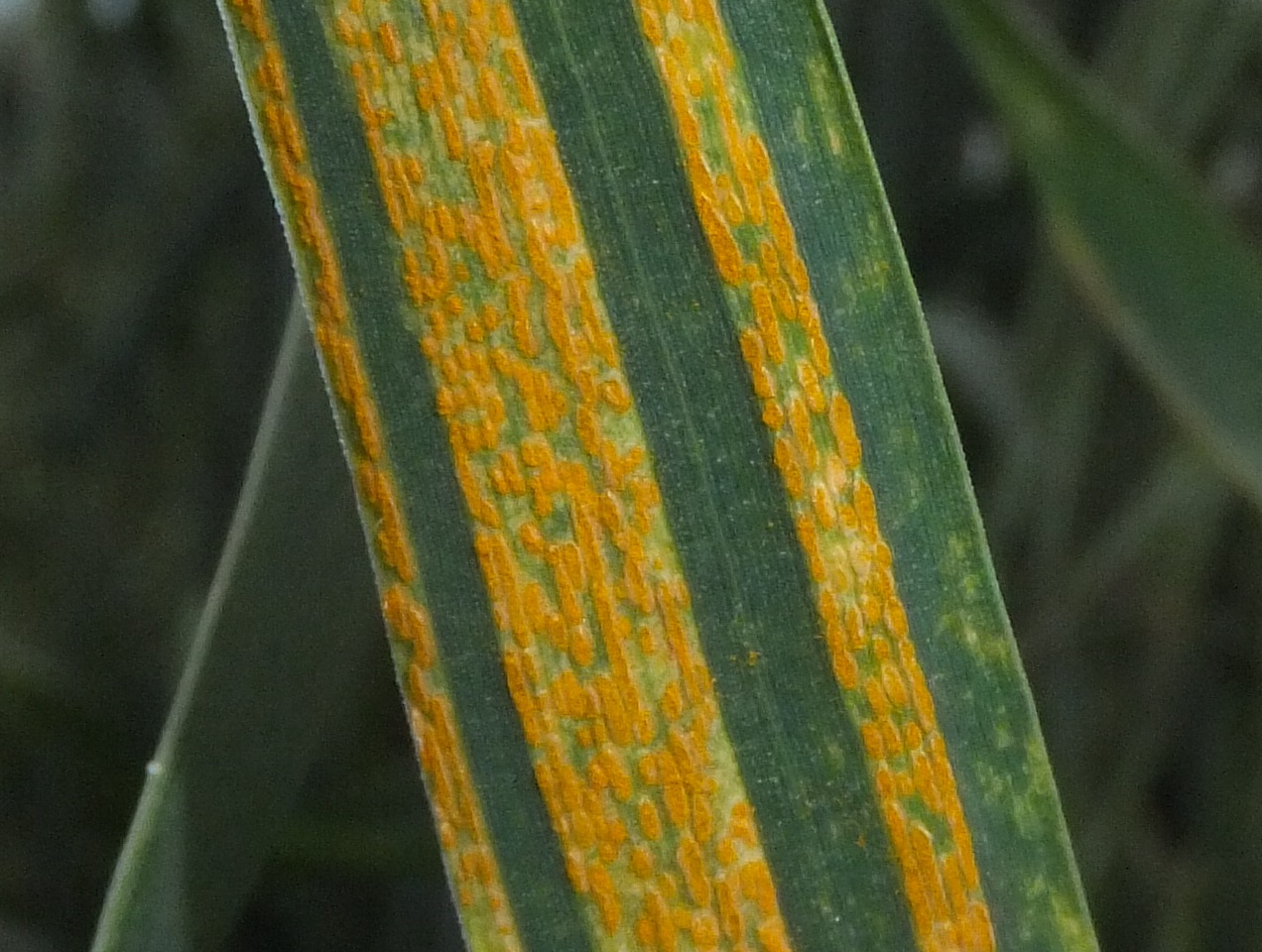
Source: farmingUK
A. Life Cycle
The life cycle of Stripe Rust is macrocyclic but typically autoecious, meaning that it does not require an alternate host to complete its life cycle in most regions.
- Urediniospores: The primary repeating spore type during the wheat growing season.
- Teliospores: These are formed at the end of the season, which give rise to basidiospores that can infect new plants under favorable conditions.
B. Symptoms
- Leaf Lesions: Stripe Rust produces yellow-orange pustules that align along the veins of wheat leaves, giving the appearance of stripes.
- Progression: Lesions typically start on the lower leaves and progressively move upward to infect new leaves and, in severe cases, spikes.
- Effect on Plant: Severe infections reduce photosynthetic ability, stunt growth, and lead to poorly filled grain heads.
C. Epidemiology
- Optimal Conditions: Stripe Rust prefers cool, wet conditions, with an optimal temperature range of 10-15°C. It is most prevalent in areas with prolonged dew periods or frequent rainfall.
- Geographic Spread: Climate change has allowed Stripe Rust to spread to regions previously too warm for the disease.
D. Management Strategies
- Resistant Varieties: Varieties with Yr genes are commonly deployed to combat Stripe Rust. However, new rust races that overcome this resistance necessitate continuous monitoring.
- Fungicide Use: Triazole and strobilurin fungicides are effective at controlling Stripe Rust, especially when applied early in the infection.
- Early Sowing: Sowing early-maturing varieties can help avoid the peak infection period.
4. Brown Rust (Leaf Rust)
Brown Rust, also known as Leaf Rust, is caused by Puccinia triticina (formerly P. recondita). It is the most common wheat rust and usually results in moderate yield losses, although it can become severe under favorable conditions.
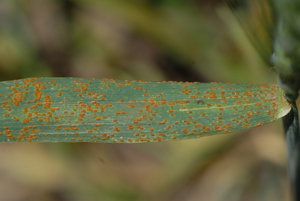
Source: Nebraska Extension Publications
A. Life Cycle
Leaf Rust is macrocyclic and heteroecious, but like Stripe Rust, the alternate host is not commonly involved in its cycle. The primary stages include:
- Urediniospores: These repeating spores infect wheat during the growing season.
- Teliospores: Produced later in the season, teliospores overwinter and initiate the cycle the following spring.
B. Symptoms
- Leaf Lesions: Small, round, orange-brown pustules form on the upper surface of the wheat leaves.
- Progression: As the disease progresses, the pustules darken due to teliospore formation.
- Effect on Plant: Severe infections cause premature leaf death, reducing photosynthesis and leading to lower grain fill.
C. Epidemiology
- Optimal Conditions: Leaf Rust prefers moderate temperatures (15-22°C) and moist environments. It often follows extended periods of wet weather, and its spores can be dispersed by wind over large distances.
- Global Spread: Leaf Rust is the most widespread wheat rust and can cause significant yield losses if not managed.
D. Management Strategies
- Resistant Varieties: Breeding for resistance involves the use of Lr genes. However, the pathogen’s ability to evolve new races requires constant development of new varieties.
- Cultural Practices: Crop rotation and the removal of crop residue can reduce inoculum levels.
- Fungicide Applications: Fungicides such as triazoles are commonly used to manage Leaf Rust outbreaks, especially in susceptible varieties.
5. Tabular Comparison of Black, Yellow, and Brown Rust
| Feature | Black Rust (Stem Rust) | Yellow Rust (Stripe Rust) | Brown Rust (Leaf Rust) |
|---|---|---|---|
| Pathogen | Puccinia graminis f. sp. tritici | Puccinia striiformis f. sp. tritici | Puccinia triticina (formerly P. recondita) |
| Common Name | Stem Rust | Stripe Rust | Leaf Rust |
| Spore Color | Reddish-brown (urediniospores); Black (teliospores) | Yellow to orange urediniospores | Orange-brown urediniospores |
| Preferred Temperature | 25-30°C | 10-15°C | 15-22°C |
| Primary Host | Wheat | Wheat | Wheat |
| Alternate Host | Barberry (Berberis spp.) | Rarely needed | Rarely needed |
| Symptoms | Elongated pustules on stems, leaves, and spikes | Yellow, stripe-like pustules on leaves | Small, round orange-brown pustules on leaves |
| Effect on Plant | Causes lodging and shriveled grain | Reduces photosynthesis, stunts growth | Premature leaf death, reduced photosynthesis |
| Management | Resistant varieties, barberry removal, fungicides | Resistant varieties, fungicides, early sowing | Resistant varieties, fungicides, crop rotation |
| Global Threat | Severe (e.g., Ug99 lineage) | Expanding due to climate change | Common but generally less severe |
6. Economic Impacts of Wheat Rust
The economic consequences of wheat rust diseases are significant, particularly in regions heavily dependent on wheat as a staple crop. Annual yield losses due to rust infections can range from 5-20%, but during severe outbreaks, losses can reach 50-100%. In addition to direct yield reductions, rust infections degrade grain quality, leading to lower market prices.
Ug99 has caused significant concern in East Africa, with potential global impacts. New virulent races of Stripe Rust are also threatening wheat yields in cooler regions, while Brown Rust remains a constant threat in temperate wheat-growing areas.
7. Global Research and Future Directions
Efforts to manage wheat rust diseases are ongoing and require an integrated approach:
- Genomic Research: Advances in plant genomics are helping breeders identify and incorporate new rust-resistance genes into wheat varieties.
- Climate Modeling: Researchers are using climate models to predict the spread of rust diseases under future climate scenarios, allowing for proactive management strategies.
- International Collaboration: Programs like the Borlaug Global Rust Initiative are essential in coordinating global efforts to combat wheat rusts, particularly in vulnerable regions.
By staying ahead of evolving rust pathogens through genetic research, integrated pest management, and global cooperation, wheat production can be safeguarded against these persistent and devastating diseases.
This comprehensive post provides a deep dive into the biology, epidemiology, and management of Black, Yellow, and Brown rusts in wheat, with an emphasis on practical and research-based solutions for farmers and scientists alike



